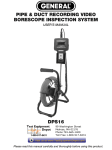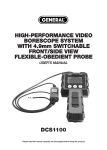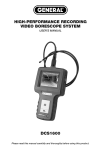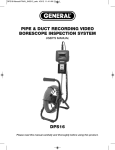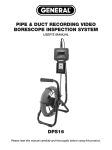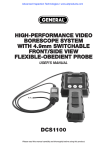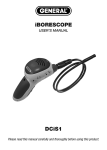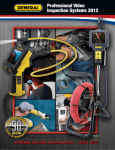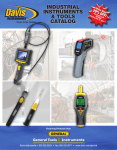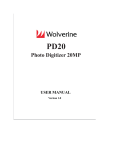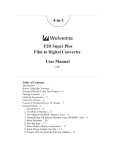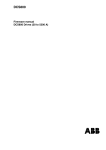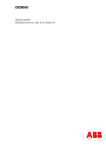Download DCS800 - Advanced Inspection Technologies
Transcript
DCS800-manual_fiNAL-030313_awb 3/1/13 12:37 PM Page 1 RUGGED HIGH-PERFORMANCE VGA RECORDING VIDEO BORESCOPE SYSTEM USER’S MANUAL DCS800 Please read this manual carefully and thoroughly before using this product. DCS800-manual_fiNAL-030313_awb 3/1/13 12:37 PM Page 2 TABLE OF CONTENTS Introduction . . . . . . . . . . . . . . . . . . . . . . . . . . . . . . . . . . . . . . . . 3 – 4 Key Features . . . . . . . . . . . . . . . . . . . . . . . . . . . . . . . . . . . . . . . 4 – 5 Safety Instructions . . . . . . . . . . . . . . . . . . . . . . . . . . . . . . . . . . . . . . 5 What’s in the Case . . . . . . . . . . . . . . . . . . . . . . . . . . . . . . . . . . . 5 – 6 Product Overview . . . . . . . . . . . . . . . . . . . . . . . . . . . . . . . . . . . 6 – 8 Setup Instructions . . . . . . . . . . . . . . . . . . . . . . . . . . . . . . . . . . 8 – 10 Install Batteries . . . . . . . . . . . . . . . . . . . . . . . . . . . . . . 8 – 9 Attach Hand Strap and Probe . . . . . . . . . . . . . . . . . . . . . . . 9 Insert SD Card . . . . . . . . . . . . . . . . . . . . . . . . . . . . . . . . . 11 Reset Auto Power Off Interval . . . . . . . . . . . . . . . . . . . . . 11 Operating Instructions . . . . . . . . . . . . . . . . . . . . . . . . . . . . . . 11 – 21 Viewing Live Video on the LCD . . . . . . . . . . . . . . . . . 11 – 13 Viewing Live Video on a TV Monitor . . . . . . . . . . . . . . . . . 13 Operating the Probe . . . . . . . . . . . . . . . . . . . . . . . . . 13 – 14 Attaching a Mirrored Viewing Tip . . . . . . . . . . . . . . . 14 Taking Pictures and Recording Videos . . . . . . . . . . . . . . . 15 Viewing Saved Videos and Pictures . . . . . . . . . . . . . 16 – 17 Navigating the Menus . . . . . . . . . . . . . . . . . . . . . . . 18 – 21 Specifications . . . . . . . . . . . . . . . . . . . . . . . . . . . . . . . . . . . . 22 – 23 Operating, Maintenance & Troubleshooting Tips . . . . . . . . . . 23 – 24 Compatible Probes and Accessories . . . . . . . . . . . . . . . . . . . . . . . 25 Warranty Information . . . . . . . . . . . . . . . . . . . . . . . . . . . . . . . . . . . 26 Return for Repair Policy . . . . . . . . . . . . . . . . . . . . . . . . . . . . . . . . . 27 2 DCS800-manual_fiNAL-030313_awb 3/1/13 12:37 PM Page 3 INTRODUCTION Thank you for purchasing General Tools & Instruments’ (General’s) DCS800 Rugged High-Performance VGA Recording Video Borescope System. Please read this user’s manual carefully and thoroughly before using the instrument. The DCS800 is a complete system that combines a handheld VGA resolution (640 x 480 pixel) recording video borescope console with General’s P16181SR-M flexible-obedient QVGA resolution probe. The included probe is 39 in. (1m) long and has a camera head diameter of 0.22 in. (5.5mm). The DCS800 console is also compatible with dozens of other high-performance VGA and QVGA resolution (320 x 240 pixel) probes from General; a complete list can be found on p. 25. The system is notable for its IP55 water ingress protection rating and its impact resistance of 1m (39 in.). The DCS800 has three operating modes: Preview, Playback and Menu: • In Preview mode, live video framed by the camera’s field of view is displayed on the console’s LCD. The DCS800 automatically enters this mode when powered on. Separate front-panel buttons allow you to increase and decrease the brightness of the four camera lighting LEDs. Another front-panel button allows you to enlarge a target by 200% (a zoom level of 3.0X) or 400% (5.0X). Yet another button allows you to “mirror” video horizontally, vertically, or horizontally and vertically at the same time. Horizontal mirroring makes it possible to read serial numbers seen and reversed by a probe with a mirrored viewing tip. Vertical mirroring makes it possible to “flip” (invert) video without having to twirl the probe 180°. With the addition of an optional VGA resolution probe from General, the DCS800 can record VGA resolution inspection videos and photos on a standard-size SD memory card with a single push of a button. While you are recording a video or before you take a photo, you can adjust the brightness of the scene or mirror or enlarge the target and these actions will be reflected in the stored file—in other words, what you see is what you save. Analog versions of stored files and raw and manipulated (zoomed and/or mirrored) real-time probe video can be exported through an included video cable to any NTSC- or PAL-format TV monitor with an RCA input jack. 3 DCS800-manual_fiNAL-030313_awb 3/1/13 12:37 PM Page 4 • In Playback mode, you can browse the SD card for saved video and picture files and view the media on the console’s LCD or on a larger TV monitor. Video clips and photos also can be viewed on a PC: 1) by removing the SD card and plugging it in directly; 2) through a card reader; or 3) via the included USB cable. Photos are saved as .jpg files, so most photo viewer applications can open them. However, although videos are saved as .avi files, Microsoft Windows Media Player lacks the codec needed to open them. Video files can be opened by more-versatile media players such as freeVLC (www.videolan.org). The 4GB SD memory card included with the DCS800 can store more than eight hours of QVGA resolution video or two hours of VGA resolution video, in addition to hundreds of photos. • In Menu mode, you use familiar up/down scrolling motions and responses to dialog boxes to navigate a main menu with six submenus. Collectively, the menus and submenus let you: • Browse and select video and photo files stored on the SD card in chronological order or reverse chronological order • Perform the following “housekeeping” functions: 1) bulk-erase the SD card; 2) set the current time and date (together known as system time) and date format; 3) enable or disable display of system time on the LCD, 4) choose any of 27 languages for menu and on-screen text, 5) select a Video Out format, and 6) adjust the triggering time of the console’s Auto Power Off function. KEY FEATURES 4 • 3.5 in. (89mm) diagonal LCD • 39 in. (1m) long, 0.22 in. (5.5mm) diameter flexible-obedient probe with 320 x 240 pixel (QVGA) resolution camera lit by four LEDs • Console, probe, and stainless steel camera head are IP55 water, oil and dust-proof. Console is also 1m (39 in.) drop-proof • Grip accepts dozens of other QVGA and VGA (640 x 480 pixel) resolution probes of various lengths and diameters to suit special applications • Records VGA or QVGA resolution video clips and still images using familiar menu-driven user interface. Saved video and photo files incorporate realtime brightness, zoom and mirroring adjustments made prior to recording or “on the fly” to optimize target clarity and detail DCS800-manual_fiNAL-030313_awb 3/1/13 12:37 PM Page 5 • Three options for mirroring live video: horizontal, vertical, or both • 4GB SD memory card • Analog video out jack and cable with RCA plug • USB cable for uploading/viewing media on SD card to PC without ejecting card • 90° mirrored probe viewing tip • Adjustable Auto Power Off interval • Choice of 27 menu languages • Custom hard plastic carrying case • Adjustable padded hand strap • 1 year limited warranty SAFETY INSTRUCTIONS CAUTION! Never insert a probe attached to the DCS800 into a structure or space known or suspected to contain live electric wiring • The DCS800 is intended for industrial applications only. Do not use it for human or any other biological inspections. • Never insert an attached probe into any flammable gas or liquid (including fuels in an oil, gasoline or diesel tank) • Do not disassemble the instrument. Doing so creates a potentially fatal electrical hazard (and voids the warranty as well). WHAT’S IN THE CASE The DCS800 comes in a custom hard plastic protective carrying case. Inside the case are: • The DCS800 console. The console integrates an LCD, a connector for a high-performance camera-tipped probe from General, separate front-panel buttons for capturing videos and photos, and six other multi-function buttons. • The P16181SR-M 5.5mm diameter QVGA resolution probe • 90° mirrored viewing tip 5 DCS800-manual_fiNAL-030313_awb 3/1/13 12:37 PM Page 6 • A 4GB full-size SD memory card • An analog cable for connecting the DCS800 to a TV monitor. The cable has a male RCA plug at one end and a mini-stereo plug at the other end. • A USB cable with a mini-USB plug on one end and a full-size USB plug on the other end. • Four “AA” Alkaline batteries • An adjustable padded hand strap • This user’s manual PRODUCT OVERVIEW Fig. 1 shows the names and locations of all of the controls, connectors and physical structures of the DCS800. Table 1 details how the function of each front-panel button changes with the console’s operating mode. Familiarize yourself with the labels, positions and functions of all buttons and connectors before moving on to the Setup Instructions and Operating Instructions. Fig. 1. The controls and connectors of the DCS800 console. P16181SR-M PROBE PROBE CONNECTOR ANALOG VIDEO OUT JACK & SD CARD SOCKET LCD USB OUT JACK SNAPSHOT BUTTON FOUR MULTIFUNCTION BUTTONS START/STOP VIDEO RECORDING BUTTON 6 CAMERA HEAD TWO MULTIFUNCTION BUTTONS BATTERY COMPARTMENT IN BACK DCS800-manual_fiNAL-030313_awb 3/1/13 12:37 PM Page 7 Table 1. The DCS800’s multi-function buttons Button Label In Preview Mode In Playback Mode In Menu Mode Decreases brightness of camera lighting LEDs N/A In Settings submenu of Date/Time menu, highlights field at left for change Increases brightness of camera lighting LEDs N/A In Settings submenu of Date/Time menu, highlights field at right for change Moves up one line within menu or submenu. In Settings submenu of Date/Time menu, increments value of highlighted field Pressed once, enlarges Selects next-oldest video or photo target 300% (zooms 3.0X). Pressed twice, enlarges target 500% (zooms 5.0X). Pressed three times, returns to 1X viewing. Pressed once, mirrors video horizontally. Pressed twice, mirrors target vertically. Pressed three times, mirrors target horizontally and vertically. Pressed four times, undoes all mirroring. Selects next-newest video or photo Moves down one line within menu or submenu. In Settings submenu of Date/Time menu, decrements value of highlighted field. Takes a picture (stores .jpg file on SD card) Begins playback of selected video clip During playback, pauses/resumes playback N/A Pressed once, starts recording an .avi video clip on SD card Pressed again, stops recording N/A N/A 7 DCS800-manual_fiNAL-030313_awb 3/1/13 12:37 PM Page 8 Button Label ESC In Preview Mode In Playback Mode In Menu Mode Opens Main Menu Offers option to delete selected video or photo file Selects highlighted item. In Settings submenu of Date/Time menu, saves displayed setting. Pressed briefly, enters Playback mode and displays newest video or photo Pressed and held, powers console off Pressed briefly, enters Preview mode Pressed and held, powers console off Pressed briefly, moves up one menu or submenu level (at Main menu level, pressing enters Preview mode). Pressed and held, powers console off. SETUP INSTRUCTIONS INSTALL BATTERIES The DCS800’s battery compartment is accessible from the back of the unit. You can use the supplied four “AA” Alkaline batteries or install your own rechargeable “AA” batteries. Rechargeable batteries will likely save you money in the long run because the DCS800 is a “high-drain” device that draws up to 2A from its ~5.5VDC battery stack when recording videos. You should not expect a set of non-rechargeable batteries to power more than 4 hours of operation. To install batteries: 1. Turn the console over and open the battery compartment by flipping up the flanged cover (see drawing at right). Set the cover aside. 2. Install four “AA” batteries in the well, using the + and – polarity marks on the inside of the cover as an orientation guide (left figure on next page). 8 DCS800-manual_fiNAL-030313_awb 3/1/13 12:37 PM Page 9 3. Replace the cover and flip it down until it snaps shut, flush against the back of the unit (right figure below). ATTACH HAND STRAP AND PROBE If you choose to use the included adjustable padded hand strap, you must install it at the same time as the camera-tipped probe because the probe secures one end of the strap. Begin by locating the end of the hand strap with the black plastic bracket and thumbscrew (see right photo below). Attach this end of the strap to the console by inserting the thumbscrew into the threaded hole on the bottom edge of the unit and tightening the screw. Then turn your attention to the other, free end of the strap. Slip the hole in the free end over the probe connector on the top edge of the console (left photo below). Then position the connector of your probe directly above the console’s probe connector. 9 DCS800-manual_fiNAL-030313_awb 3/1/13 12:37 PM Page 10 To attach the included P16181SR-M probe (or another compatible probe from General), mate its connector with the probe connector at the top of the DCS800 console. The connectors mate in only one way, when the two dots—one on the console’s connector and the other under the collar at the end of the probe—are aligned. After you have lined up the dots, push the two connectors together so the alignment keys on opposite sides of the probe’s connector slide over the flats of the console’s connector. Slide the collar on the probe’s connector forward and tighten the collar by turning it clockwise (see figure at right). Tightening the collar will also secure the top end of the strap to the console. The right photo at the top of the previous page shows the final arrangement. You can now remove the protective rubber cap from the camera-tipped end of the probe. It is good practice to replace the cap whenever the probe will not be used for a while. Now is also the time to peel away and discard the plastic film that protects the console’s LCD. To disconnect the probe from the console later, turn the collar counterclockwise and pull the probe straight out and away. INSERT SD CARD 1. Lift up the bottom of the rubber cover on the right side of the console (see figure at right) to expose the SD card socket and Analog video out jack. 2. Remove the supplied SD card or another card of up to 32GB capacity from its packaging. Discard the packaging but save the plastic storage case. 3. Plug the SD card into the socket. Be sure the card’s gold contacts face the rear of the console and enter the socket first. Push in the card until you feel it spring back and you hear a click. To remove the card later, push it in gently until you hear a click and the card pops out far enough for your fingers to grab. 10 DCS800-manual_fiNAL-030313_awb 3/1/13 12:37 PM Page 11 RESET AUTO POWER OFF INTERVAL By default, the Auto Power Off function of the DCS800 is disabled. To minimize how often you must change or recharge the instrument’s batteries, General strongly recommends that you reset the Auto Power Off interval to 5 or 10 minutes of inactivity at the front-panel buttons. Having the DCS800 occasionally power off on its own is only a minor inconvenience because the unit can be restarted in less than 5 seconds. To change the Auto Power Off interval: 1. Power on the console by pressing the button and holding it for at least 3 seconds. 2. Press the button to open the main menu. DELETE ALL FILES will be highlighted. 3. Press the button once to scroll up to and highlight the AUTO POWER OFF line. 4. Press the button to open the AUTO POWER OFF submenu. OFF will be highlighted. 5. Press the button to scroll down to and highlight the 5 MINUTE or 10 MINUTE line. 6. Press the button to save your selection. 7. Press the button once to return to Preview mode. ESC ESC OPERATING INSTRUCTIONS VIEWING LIVE VIDEO ON THE LCD If you followed the procedure for resetting the Auto Power Off interval in the previous section, you have already experienced powering the DCS800 on. Each time you power the unit on— or return to Preview (live video) mode from Playback or Menu Battery power mode—the screen at right will appear on the LCD. System Time 12/31/2012 12:35:45 Memory card capacity 11 DCS800-manual_fiNAL-030313_awb 3/1/13 12:37 PM Page 12 The two “vital signs” of the DCS800—remaining battery power (in white, at lower left) and remaining SD card capacity (in green, at lower right)—will appear for four seconds, superimposed on video being captured in real time by the camera at the end of the probe. A fully charged set of batteries would be represented by a completely white icon. The width of the bright-green area at the left of the SD card icon reflects how much capacity is already used. A card that is nearly full would be represented by a bar that is green almost to its right edge. After four seconds, both vital sign indications will disappear, leaving only the system time at the top of the screen. You must manually enter the system time (which includes the date) via the Date/Time submenu; see pages 19 and 20 for instructions. Time and date settings are retained following battery changes and system resets. To increase the brightness of the display, press the button. To decrease brightness, press the button. In a brightly lit room, changing the intensity of the LEDs at the tip of a probe has only a small effect on the brightness of video on the screen. The on-screen impact of changing brightness is more pronounced in dark environments. To horizontally “mirror” live video, press the button once. Horizontal mirroring makes it easier to read equipment labels and serial numbers, as shown at right. An icon of a mountain with twin peaks will appear at the lower right of the screen to indicate that horizontal mirroring is in effect. To vertically mirror live video, press the button twice. Vertical mirroring makes it possible to “flip” (invert) video—so upside-down scenes appear rightside up—without having to twirl the probe 180°. Note that changing from horizontal mirroring to vertical mirroring vertically flips the mountain icon at the bottom right of the LCD. To mirror video horizontally and vertically at the same time, press the button three times. Note that adding horizontal mirroring to vertical mirroring horizontally flips the mountain icon, making the taller peak appear to the left of the shorter peak. To zoom in on a target, press the button. Pressing the button once enlarges the target by 200% (a zoom level of 3.0X). Pressing the button twice 12 DCS800-manual_fiNAL-030313_awb 3/1/13 12:37 PM Page 13 enlarges the target by 400% (a zoom level of 5.0X). When video is being zoomed, the zoom level is indicated at the bottom right of the display, as shown below. Pressing the button a third time returns to 1X (actual size) viewing. The effects of mirroring and zooming are visible individually or together when viewing video either on the DCS800’s LCD or on a TV monitor—the subject of the next section. VIEWING LIVE VIDEO ON A TV MONITOR The DCS800 comes with a video cable for connecting the console to any TV or TV monitor that uses either the NTSC or PAL analog broadcast standard. By making the connection, you can view live video, or saved videos and pictures, on a screen larger than the DCS800’s. To make the connection, insert the yellow RCA plug of the video cable into the Video in jack of your TV monitor and set the TV’s input to external video. Then insert the stereo mini-plug of the cable into the Analog video out jack on the right side of the console below the SD card socket (see Fig. 1). Inserting the plug “blanks out” the DCS800 LCD. Before making the connection, make sure that your DCS800 is configured to export video in the same format as your TV or TV monitor. The default format is NTSC. To switch to PAL format, follow the instructions on p. 21. OPERATING THE PROBE The P16181SR-M is a high-performance camera-tipped probe that captures video and still images at QVGA (320 x 240 pixel) resolution. The probe’s four bright white LEDs make it particularly suitable for inspecting dark environments and viewing parts and structures within them. The P16181SR-M uses a flexible-obedient (semi-rigid) design that retains its configured shape and is therefore better for inspecting behind walls, under floors and above ceiling than a “soft metal” probe that does not retain its bent shape. Because soft metal probes are so flexible, they are better suited for inspecting the interior of pipes or densely packed equipment enclosures (such as engine compartments). 13 DCS800-manual_fiNAL-030313_awb 3/1/13 12:37 PM Page 14 General offers as optional accessories many soft metal probes of various lengths and diameters to suit a wide range of applications. Among them are six articulating probes, three with a VGA resolution camera (P16HPART/ P16HP2ART/P16HP3ART) and three with a QVGA resolution camera (P16ART1SM/2SM/3SM). All six, in effect, let you set their viewing angle over a 300° arc centered on the probe’s main axis. The table on p. 25 lists the part numbers and key specifications of all General probes compatible with the DCS800. You can also change the viewing angle of the probe (enabling it to see around corners) by attaching the included 90° mirrored viewing tip to the camera head. See below for attachment instructions. Before using the DCS800 system, carefully read the Operating, Maintenance & Troubleshooting Tips section of this manual on p.23 to understand how to use a borescope probe properly and avoid using it improperly. To protect the delicate camera-tipped end of the P16181SR-M probe, reinstall the rubber lens cap after each inspection session. Don’t forget to remove the cap from the tip of the probe before using it again. The DCS800 can be powered for up to four hours by the same set of four “AA” batteries. It’s time to replace the batteries when the battery icon appears at the lower left of the display during viewing of live video. The first sign of weak batteries is a change in the appearance of the icon from a steady white to a flashing red. When the batteries are critically low on charge, the flashing will stop and the icon will switch to a solid red. To replace the batteries, follow the procedure on pages 8 and 9 of this manual. Attaching the Mirrored Viewing Tip Among the accessories included with the DCS800 is a mirrored tip with a viewing angle of 90°. To attach it to the probe: 1. Pull off the rubber protective cap. 2. Unscrew and remove the black metal thread protector ring at the tip of the probe, as shown at right. 3. Screw the mirrored viewing tip onto the camera head by turning it clockwise, as shown at right. Keep turning until the viewing tip is as far from the probe tip as possible. 4. Remove the blue circular protective film from the mirror by pulling on its tab with a tweezers. Be careful not to scratch the mirror in the process. 14 DCS800-manual_fiNAL-030313_awb 3/1/13 12:37 PM Page 15 TAKING PICTURES AND RECORDING VIDEOS To take a picture, make sure the DCS800 is in Preview mode (with live video appearing on the LCD), optimize the 11/30/2012 12:35:45 display brightness and zoom level for the target, and press the button. Pressing the button creates a .jpg file of the field of view at that moment and stores it on the SD PICT000.JPG P card. The alphanumeric name of the stored picture file, which begins with “PICT” and has the suffix “.JPG”, is briefly displayed in orange at the bottom of the LCD (see photo at right) to confirm that a picture was taken and saved. The DCS800 automatically returns to Preview mode after taking a picture. 1 To record a video clip, make sure the DCS800 is in 12/30/2012 12:35:45 Preview mode and press the button. Doing so begins creating an .avi video file (with MPEG-4 compression) for 0 storage on the SD card. An orange running clock indicating • 00:00:12 the duration of the clip recorded so far will appear at the lower left of the screen (see photo at right) and remain there until the recording is stopped. To stop recording, press the button again. This causes the orange running clock to disappear and returns the DCS800 to Preview mode. As the clip is ended, its file name is briefly displayed in orange at the bottom of the screen to confirm that the clip was stored. Like photo files, video files begin with the letter PICT; unlike photo files, video files have the suffix “.AVI”. In the DCS800, files are named consecutively, regardless of type. For example, if you first take a picture and then record a video, the first file would be named PICT0001.JPG and the second PICT0002.AVI. While a video is being recorded, the following console buttons remain active: and (brightness up and down), (mirror) and (zoom). The effects of mirroring and changing brightness and zoom level are reflected in the video recording. You cannot pause the recording of a video clip and resume it later; to cover two time spans, you must record two videos. The DCS800 will be unable to store videos and pictures if its SD memory card is full, write-protected or damaged. When the instrument senses any of these conditions, it will superimpose the words SD CARD FULL at the bottom of the screen in red. To remedy the situation, either replace the full SD card by another card with spare capacity, or delete files individually or in bulk. Instructions for deleting files can be found later in this user’s manual. 15 DCS800-manual_fiNAL-030313_awb 3/1/13 12:37 PM Page 16 VIEWING SAVED PHOTOS AND VIDEOS To view a picture or play back a video on the DCS800’s LCD or a TV monitor, switch the unit out of Preview mode and into Playback mode by pressing the button. The DCS800 will then recall and display either a still photo (if a photo was the last recording stored) or the first frame of a video clip (if a video was the last recording). In both cases, two pieces of information about the file will be displayed briefly: its name (in orange at the bottom of the LCD) and its position in the recording sequence (for example, 16/16) in white in the upper right corner of the LCD. For video clips, another piece of information will also be shown: its duration, in the upper left corner of the LCD. In Playback mode, pressing the button repeatedly sequentially recalls all photos and videos from memory in the reverse order in which they were stored (in other words, the newest first and the oldest last). By contrast, pressing the button repeatedly sequentially recalls all stored photos and videos from memory in the same order in which they were stored (the oldest first and the newest last). To begin playing back a video whose first frame is on-screen, press the button. Once a video clip begins playing, a running clock and moving timeline will help you compare what you see now against what you saw when you recorded the clip. You can pause and resume the clip as often as you like by pressing the button to toggle between the two actions. During video playback, pressing the button stops the video and cues it up to its first frame, ready to be restarted. Whenever a photo or (the first frame of) a video clip is on-screen in Playback mode, pressing the button gives you the opportunity to delete it from the SD card. The word DELETE will appear in white at the left of the screen and the term [OK] will appear at right. Press the button to delete the file representing the image or first frame of a video clip shown on-screen. Photos and videos stored on the SD card also can be viewed on a PC. If your computer has an SD card slot, you can remove the SD card from your DCS800 and plug it directly into your PC. If your PC does not have an SD card slot, you can purchase a USB SD card reader (Part No. SDRD1) from General. Alternatively, you can use the included USB cable to transfer video clips and pictures stored on the SD card to a PC for viewing on the PC’s larger screen or exporting elsewhere. ESC ESC 16 DCS800-manual_fiNAL-030313_awb 3/1/13 12:37 PM Page 17 To connect the DCS800 to a PC: 1. Insert the full-size USB plug at one end of the cable into a USB port of your PC. 2. Insert the mini-USB plug at the other end of the cable into the USB Out jack on the left side of the DCS1700 console (see Fig.1). 3. Making the USB connection will cause the DCS800 LCD to superimpose the phrase MASS-STORAGE MODE over live video. On most PCs, making this connection will activate AutoPlay. In the General options section of the AutoPlay screen, choose “Open folder to view files”. Doing so will give you access to the SD card’s content via its hierarchical file structure. At the top of the hierarchy is a folder named “DCIM”. Details of the SD card’s file structure are worth mentioning to underscore the importance of not changing any factory-assigned folder names. As the figure below shows, the SD card has been formatted to contain one folder named “DCIM” and one subfolder named “100COACH”. The 100COACH folder contains all stored photo and video files, identified by their.JPG and .AVI extensions. You should not rename the DCIM and 100COACH folders while the SD card is inside your PC or connected to it to through a card reader. If you rename PICT00XX.JPG DCIM 100COACH PICT00XX.AVI either folder, the DCS800 will fail to recognize the SD card the next time you plug it into the console. If you choose to remove the SD card from the console and plug it into a PC, either directly or through a card reader, remember to eject the card from the PC once you are done viewing (and/or copying) the files stored on the card. Depending on your PC’s startup settings, your computer may fail to restart following its next shutdown if the SD card remains inserted. The PC’s operating system may try to reboot from the SD card and be unable to do so. Finally, remember to disable the Auto Power Off function of the DCS800 if you expect to view SD card content on a PC via the USB cable for longer than the APO triggering time. If you allow the APO function to activate during your viewing session, you must power on the unit again and then remove and reinsert the USB cable before you can resume viewing. 17 DCS800-manual_fiNAL-030313_awb 3/1/13 12:37 PM Page 18 NAVIGATING THE MENUS The Main menu of the DCS800—accessible by pressing the button—has six submenus for accessing and controlling the following operational and housekeeping functions: • The DELETE ALL FILES submenu lets you bulk-erase the contents of the SD card • The AV OUTPUT menu’s function is automatically enabled when you plug the included Analog video output cable into the console’s Analog video out jack. • The DATE/TIME submenu lets you set the current date and time (together known as system time) and the date format. It also lets you choose whether to superimpose the system time on live video. Be aware that you cannot change the Year/Month/Day (Y/M/D) format used for photo time stamps. • The LANGUAGE submenu lets you choose one of 27 languages for on-screen notifications and menu items • The TV SYSTEM submenu lets you choose the analog video output format (NTSC or PAL) compatible with your TV or TV monitor • The AUTO POWER OFF submenu lets you determine the triggering time of the Auto Power Off function (never, 5 minutes, 10 minutes, 15 minutes or 30 minutes) The six submenus are navigated in identical fashion. When any submenu is selected and opened by pressing the button, its name is displayed in white at the top of the LCD. No more than three options are presented in rows below, as in the figure at right: Scrolling an option to the middle of screen highlights it and makes it available for selection. Pressing the button saves the setting and automatically switches the display to the next-highest level of that menu or submenu. The effect is identical to what happens when you press the “up one level” button in a traditional computer folder-subfolder hierarchy. Finally, remember that once you open any menu or submenu, you have two minutes and 30 seconds (2:30) to select an option before the menu automatically closes, returning the DCS800 to its default Preview operating mode. 18 DCS800-manual_fiNAL-030313_awb 3/1/13 12:37 PM Page 19 The DELETE ALL FILES submenu Submenu name Options Instructions/Comments DELETE ALL FILES Yes No (default) Choose YES to delete all files on the SD card. Choose NO to preserve all files. When your selection is highlighted, press the button to take the action and return to the Main menu. The AV OUTPUT submenu Submenu name Options Instructions/Comments N/A N/A The function of this submenu has been automated. Selecting AV OUTPUT generates the following on-screen message: NO AVOUT CABLE. Plugging the included Analog video out cable into the Analog video out jack automatically blanks out the LCD and sends live video or saved video clips and pictures to a compatible TV or TV monitor. The DATE/TIME submenu Submenu name Options Instructions/Comments SETTINGS Current date Current time A) To enter the current date in the default format of Y/M/D (year, month, day): 1) Press the or button to increase or decrease the Y value. Then press the button to advance to and highlight the M field; 2) Press the or button to increase or decrease the M value. Then press the button to advance to and highlight the D field; Press the or button to increase or decrease the D value. Then press the button to advance to and highlight the hours field. 19 DCS800-manual_fiNAL-030313_awb 3/1/13 12:37 PM Page 20 B) To set the current time: 1) Press the or button to increase or decrease the value in the hours field to match the current hour in 24-hour (military time) format. Then press the button to advance to and highlight the minutes field; 2) Press the or button to increase or decrease the minutes value to match the current value. Then press the button to advance to and highlight the seconds field; 3) Press the or button to increase or decrease the seconds value. Finally, press the button to save both the date and time settings and return to the DATE/TIME menu. FORMAT Y/M/D (default) To change the date format of system time: M/D/Y 1) Use the the or button to cycle through D/M/Y the three options: Y/M/D (default), M/D/Y and D/M/Y. 2) With your preference highlighted, press the button to save the setting and return to the DATE/TIME menu. DISPLAY YES (default) NO Select YES to always show the system time (current date and time) on-screen in Preview (live video) mode. Select NO to never show the system time on-screen. The LANGUAGE submenu Submenu name Options Instructions/Comments N/A English, French, German, Italian, Spanish, Portuguese, Japanese, Traditional Chinese, Simplified Chinese, Danish, Dutch, Polish, Russian, Bulgarian, Turkish, Swedish, Finnish, Norwegian, Estonian, Lithuanian, Latvian, Hungarian, Czech, Slovak, Slovenian, Romanian, Greek Selects language of screens, menus and submenus. Use the or button to navigate to your preference and highlight it. Then press the button to save the selection and return to the Main Menu. 20 DCS800-manual_fiNAL-030313_awb 3/1/13 12:37 PM Page 21 The TV SYSTEM submenu Submenu name Options N/A NTSC (default) Choose NTSC in North America, Central PAL America, Japan, South Korea and Taiwan. Choose PAL in Europe, Africa and much of Asia and Africa. When your selection is highlighted, press the button to save the setting and return to the Main Menu. Instructions/Comments The AUTO POWER OFF submenu Submenu name Options Instructions/Comments AUTO POWER OFF OFF (default) 5 MINUTE 10 MINUTE 15 MINUTE 30 MINUTE Choose OFF to disable the Auto Power Off function (not recommended except when viewing saved videos and pictures on a PC via a USB link). Choose 5 MINUTE, 10 MINUTE, 15 MINUTE or 30 MINUTE to automatically power off the DCS800 after that duration of inactivity on front-panel buttons. When your selection is highlighted, press the button to save the setting and return to the Main menu. 21 DCS800-manual_fiNAL-030313_awb 3/1/13 12:37 PM Page 22 SPECIFICATIONS Display Size, Type 3.5 in. (diagonal), color TFT LCD Display Resolution 320 x 240 pixels (QVGA) Probe Length, Type, Diameter 39 in. (1m), flexible-obedient, 0.22 in. (5.5mm) Diameter of Camera Head with Thread Protector 0.23 in. (6mm) System Ingress Protection To water, oil & dust per IP55 standard System Impact Resistance Drop from height of 1m (39 in.) Probe Camera Resolution 320 x 240 pixels (QVGA) Probe Depth of Field 0.25 to 12 in. (6.4 to 300mm) Probe Field of View 46° (horizontal), 34° (vertical), 56° (diagonal) Camera Lighting 4 white LEDs Console Recording Resolution 640 x 480 pixels (VGA) Video File Format .avi Photo File Format .jpg Video Zoom Options 3.0X, 5.0X Interfaces Analog video & USB 2.0 jacks Video Out Formats NTSC and PAL Video Frame Rate 30 frames per second (fps) Compression Format Compatible with MPEG4 Recording Medium Standard-size SD card of up to 32GB capacity Menu Languages English, French, German, Italian, Spanish, Portuguese, Japanese, Traditional Chinese, Simplified Chinese, Danish, Dutch, Polish, Russian, Bulgarian, Turkish, Swedish, Finnish, Norwegian, Estonian, Lithuanian, Latvian, Hungarian, Czech, Slovak, Slovenian, Romanian, Greek 22 DCS800-manual_fiNAL-030313_awb 3/1/13 12:37 PM Page 23 Specifications (continued) Probe Operating/Storage Temperature -4° to 140°F (-20° to 60°C) Console Operating Temperature 32° to 140°F (0° to 60°C) Dimensions of Console 5.5 x 4.6 x 1.7 in. (140 x 116 x 42mm) Weight of Console (without Batteries) 10.6 oz. (300g) Power Source (4) “AA” Alkaline or rechargeable Ni-MH batteries Battery Life (typical) 4 hours operation OPERATING, MAINTENANCE & TROUBLESHOOTING TIPS • Never remove the SD card while taking a picture or recording a video. Doing so may damage the card and erase or corrupt the photo or video. • If the LCD suddenly goes dark, the first two things to check are the integrity of the console’s connection to the probe and the charge of the console’s batteries. The reason for the failure also could be that you have forgotten to remove the rubber cap protecting the probe tip. • If live video begins to look spotty, streaky or intermittent, the likely reason is weak batteries. • To change batteries, follow the procedure on pp. 8 and 9. To gain access to the battery compartment, you only need to detach the bottom end of the hand strap. • Avoid using corrosive liquids such as alcohol to clean either the console or the probe. To clean the camera’s lens and LEDs and the LCD, use a cotton swab moistened with water and wipe dry with a microfiber cloth. To clean the housing of the console, use a soft, dry cloth. • Operate and store the DCS800 only in a cool (under 140ºF or 60ºC), dry, well-ventilated place. Avoid exposing the unit to sunlight for long periods of time. • To avoid damaging the console’s probe connector, use only compatible probes. 23 DCS800-manual_fiNAL-030313_awb 3/1/13 12:37 PM Page 24 • Never use the probe or camera head to modify surroundings or to clear pathways or clogged areas. • The camera head, LEDs and thread protector ring are waterproof, but not acid-proof or fire-proof. Do not touch acidic, corrosive or hot materials or they will ruin the head. • Cover the camera-tipped end of the probe with the protective rubber cap when not using it. • Unless you wish to install the mirrored viewing tip, do not unscrew the thread protector ring from the camera head. • When inspecting a vehicle, shut off the engine. Metal and liquid under the hood may be hot. Do not get oil or gas on the camera head. • If condensation forms inside the camera lens, let it evaporate before using the probe again. • Do not try to disassemble any part of the probe. Doing so creates an electrical hazard, could damage the probe, and voids the limited warranty. • Remove the batteries if you expect to store or not use the DCS800 for an extended period of time (months). 24 DCS800-manual_fiNAL-030313_awb 3/1/13 12:37 PM Page 25 COMPATIBLE PROBES & ACCESSORIES The table below lists and describes all probes and accessories compatible with the DCS800. Model No. (SKU) P16ART-1SM P16ART-2SM P16ART-3SM P16HPART P16HP2ART P16HP3ART P16181SR-M P16182SR-M P16183SR-M P16181SM-M P16183SM-M P16185SM-M P161810SM-M P161830SM-M P1839-M P16182-39 P16183-39 P1618FS-49 P16182-49 P16183-49 Description Soft Metal Articulating Probe Camera Head Diameter 6mm (0.23 in.) VGA Resolution Articulating Probe Flexible-Obedient Probe (P16181SR-M included with DCS800 system) 5.5mm (0.22 in.) Soft Metal Probe Ultra-Slim Flexible-Obedient 3.9mm (0.15 in.) Probe Probe Length 1m (3.3 ft.) 2m (6.6 ft.) 3m (9.8 ft.) 1m (3.28 ft.) 2m (6.6 ft.) 3m (9.8 ft.) 1m (3.3 ft.) 2m (6.6 ft.) 3m (9.8 ft.) 1m (3.28 ft.) 3m (9.8 ft.) 5m (16 ft.) 10m (32 ft.) 30m (98 ft.) 1m (3.3 ft.) 2m (6.6 ft.) 3m (9.8 ft.) 1m (3.3 ft.) 2m (6.6 ft.) 3m (9.8 ft.) Depth of Field 0.25 to 12 in. (6.4 to 300mm) Switchable Front/Side View Flexible-Obedient Probe 4.9mm (0.19 in.) VGA Resolution Probe 5.5mm (0.22 in.) Pipe & Duct Inspection Probe & Reel Set 28mm (1.1 in.) 22m (72 ft.) 0.4 in. (10mm) to infinity RP1618 Reel Stand for Long Soft Metal Probes ——— ——— ———— HT1618 Telescoping Rigid Holding Tube for Articulating Probes ——— ——— ———— P16181HP P16182HP P16183HP P16PIP 1m (3.3 ft.) 2m (6.6 ft.) 3m (9.8 ft.) 25 DCS800-manual_fiNAL-030313_awb 3/1/13 12:37 PM Page 26 For more information, begin by visiting www.generaltools.com and entering the Model No. in the SEARCH box at the top of the home page. To order a probe, click on the link for a list of its General-certified distributors and retailers. WARRANTY INFORMATION General Tools & Instruments’ (General’s) DCS800 Rugged High-Performance VGA Recording Video Borescope System is warranted to the original purchaser to be free from defects in material and workmanship for a period of one year. Subject to certain restrictions, General will repair or replace this instrument if, after examination, the company determines it to be defective in material or workmanship. This warranty does not apply to damages that General determines to be from an attempted repair by non-authorized personnel or misuse, alterations, normal wear and tear, or accidental damage. The defective unit must be returned to General Tools & Instruments or to a General-authorized service center, freight prepaid and insured. Acceptance of the exclusive repair and replacement remedies described herein is a condition of the contract for purchase of this product. In no event shall General be liable for any incidental, special, consequential or punitive damages, or for any cost, attorneys’ fees, expenses, or losses alleged to be a consequence of damage due to failure of, or defect in any product including, but not limited to, any claims for loss of profits. 26 DCS800-manual_fiNAL-030313_awb 3/1/13 12:37 PM Page 27 RETURN FOR REPAIR POLICY Every effort has been made to provide you with a reliable product of superior quality. However, in the event your instrument requires repair, please contact our Customer Service to obtain an RGA (Return Goods Authorization) number before forwarding the unit via prepaid freight to the attention of our Service Center at this address: General Tools & Instruments 80 White Street New York, NY 10013 212-431-6100 Remember to include a copy of your proof of purchase, your return address, and your phone number and/or e-mail address. 27 DCS800-manual_fiNAL-030313_awb 3/1/13 12:37 PM Page 28 GENERAL TOOLS & INSTRUMENTS 80 White Street New York, NY 10013-3567 PHONE (212) 431-6100 FAX (212) 431-6499 TOLL FREE (800) 697-8665 e-mail: [email protected] www.generaltools.com DCS800 User’s Manual Specifications subject to change without notice ©2013 GENERAL TOOLS & INSTRUMENTS NOTICE - WE ARE NOT RESPONSIBLE FOR TYPOGRAPHICAL ERRORS. MAN# DCS800 3/1/13






























